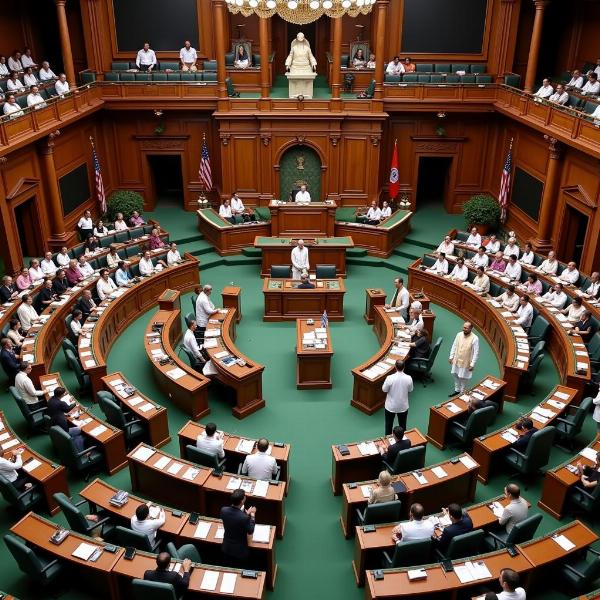The term “ruling party” in Hindi is commonly translated as “sattadhar dal” (सत्तारूढ़ दल). Understanding the meaning of “sattadhar dal” is crucial for anyone following Indian politics. It refers to the political party that holds the majority of seats in the legislature (either at the national or state level) and thus forms the government. This article will delve deeper into the significance of the ruling party, its role in Indian democracy, and the nuances associated with the term.
Decoding ‘Sattadhar Dal’: More Than Just a Majority
While having the majority of seats is the primary criterion for forming the government and becoming the “sattadhar dal”, the implications extend far beyond just numbers. The ruling party sets the political agenda, implements policies, and controls the administrative machinery. Its actions directly impact the lives of citizens. “Satta” (सत्ता) itself means power or authority, highlighting the significant influence the “sattadhar dal” wields.
 Indian Parliament with the ruling party in session
Indian Parliament with the ruling party in session
Responsibilities and Challenges of the ‘Sattadhar Dal’
Being the “sattadhar dal” comes with significant responsibilities. The party is accountable for the country’s economic development, social welfare, and national security. They must uphold the constitution and ensure good governance. However, maintaining this power and fulfilling these responsibilities presents several challenges, including managing internal dissent, navigating complex political alliances, and addressing public expectations.
‘Sattadhar Dal’ vs. ‘Vipaksh Dal’: The Dynamics of Power
The “sattadhar dal” is constantly scrutinized by the opposition party, known as “vipaksh dal” (विपक्ष दल). This dynamic creates a system of checks and balances crucial for a healthy democracy. The “vipaksh dal” plays a vital role in holding the ruling party accountable and offering alternative perspectives on policy matters.
The Impact of the ‘Sattadhar Dal’ on Policy Making
The “sattadhar dal’s” ideology and agenda significantly influence the policies enacted. This impact is evident in various sectors, including education, healthcare, and economic development. Understanding the “sattadhar dal’s” political stance is crucial for comprehending the direction of the country’s policies.
How Elections Influence the ‘Sattadhar Dal’
In a democratic system like India’s, regular elections determine the “sattadhar dal”. The electoral mandate empowers the winning party to form the government and implement its agenda. This process ensures that the “sattadhar dal” remains accountable to the people.
Conclusion: ‘Sattadhar Dal’ – The Heart of Indian Democracy
The “ruling party” or “sattadhar dal” plays a pivotal role in shaping India’s political landscape. Understanding its meaning and significance is essential for engaging with the country’s political system. By comprehending the dynamics of the “sattadhar dal”, we can better understand the forces that shape our nation’s future.
FAQ:
- What does ‘satta’ mean in Hindi? ‘Satta’ means power or authority.
- What is the opposite of ‘sattadhar dal’? The opposite is ‘vipaksh dal’, meaning the opposition party.
- How is the ‘sattadhar dal’ chosen in India? Through democratic elections.
- What are the responsibilities of the ‘sattadhar dal’? Governing the country, implementing policies, and ensuring national security.
- Why is understanding the ‘sattadhar dal’ important? It helps understand the direction of the country’s policies and political landscape.
- Can the ‘sattadhar dal’ change? Yes, through elections.
- Does the ‘sattadhar dal’ have unlimited power? No, it is checked by the opposition and the constitution.
Meaning-Hindi.in offers expert translation services in Hindi and other languages, specializing in business, legal, technical, website localization, educational, and urgent translation needs. Our expertise ensures accurate and culturally sensitive translations for diverse clients. Need translation assistance? Contact us at [email protected] or call us at +91 11-4502-7584. Meaning-Hindi.in is your trusted partner for bridging language barriers.